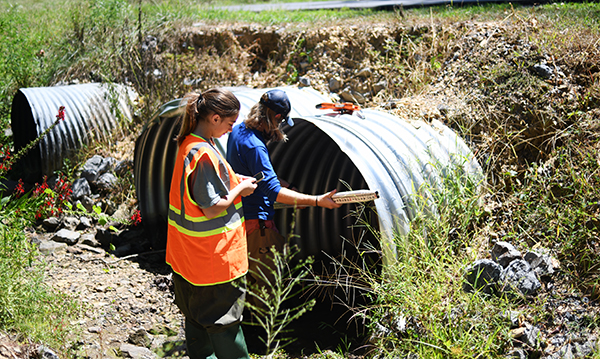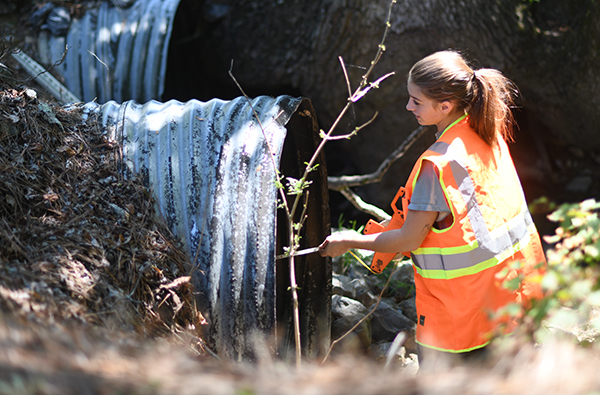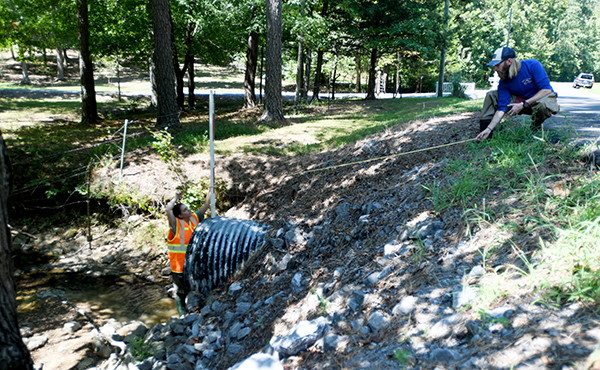News
Students Join Nationwide Conservation Effort, Help Local Ecosystems
09/17/19
 Crawling through culverts under roads isn’t how Neeley Keeton and Stuart Duncan initially envisioned spending their days, especially in 90-degree heat.
Crawling through culverts under roads isn’t how Neeley Keeton and Stuart Duncan initially envisioned spending their days, especially in 90-degree heat.
But, through an internship, they’ve joined a national effort to assess culverts so they can be repaired or replaced to improve water connectivity and local habitats.
“Before I started working on this project I never really thought of the importance of culverts,” said Keeton, a biology student at Dalton State College who expects to graduate in December of 2020. “When you see one in need of replacing or repair, you see all the ways it affects the environment. It’s so important that water flows freely through the culverts so that fish and other animals can move up and downstream. A properly installed culvert makes the entire stream healthier.”
The culvert project is part of a nationwide effort to improve aquatic connectivity, which is spearheaded locally by the Southeast Aquatic Resources Partnership (SARP). SARP is a regional collaboration of natural resource and conservation organizations. Thanks to a Southeast Aquatic Fund grant through the National Fish and Wildlife Foundation, culverts are being assessed for fish passage problems.
Dalton State is partnering with The Nature Conservancy and Limestone Valley Resource Conservation and Development (RC&D) in this effort to evaluate culverts in the Holly Creek watershed in Murray County. Holly Creek is a tributary to the Conasauga River, which divides Murray and Whitfield counties and is one of the most biodiverse rivers in the nation and home to endangered species.
Some of the areas being surveyed are Rock Creek, Yellow Creek, Chicken Creek, Stewart Branch, Wright Branch and waterways under U.S. Highway 411 and state Highway 225.
The students have found areas where a pool of  fish is completely separated from the main water source due to a damaged culvert. Others have man-made barriers over them that were most likely used to protect farm animals but hinder aquatic life.
fish is completely separated from the main water source due to a damaged culvert. Others have man-made barriers over them that were most likely used to protect farm animals but hinder aquatic life.
“We’re biology students and just now seeing this first hand,” said Duncan, who graduated this summer with a biology degree from Dalton State. “I imagine people living around here have no idea of the true impact of culverts. While we’ve been in the field, we’ve talked a lot to nearby landowners. They’re really nice and ask about what we’re doing. They seem to have a true interest in the project.”
Keeton and Duncan measure the culverts, take photos of them, report on the condition of water flow, measure road fill height and note other observances. The data will be used to prioritize which culverts need to be replaced or repaired.
“The Holly Creek watershed is home to several federally listed threatened and endangered species and is regarded as one of the most biologically diverse aquatic ecosystems in the country,” said Matt Heath with the Limestone Valley RC&D, a nonprofit organization focusing on conservation, water improvement and sustainable agriculture through Northwest Georgia. “Research has shown that undersized and perched culverts may be preventing aquatic organism passage and creating habitat fragmentation in the Holly Creek watershed. This, in turn, can create inbreeding and prevent species distribution throughout their native range.
“With the help of Stewart Duncan, Neely Keeton, Dr. John Lugthart and several wonderful volunteers, we have been making steady progress in the completion of our 200 site assessments,” Heath said. “It's inspiring to see the passion of Dalton State's students and their drive to be a part of conservation efforts in their local communities. The data collected through this project will be an important part in the protection of Holly Creek's unique aquatic ecosystem.
Lugthart said the partnership between the agencies precedes the culvert project but this is the largest conservation effort the agencies have worked on together.
“We’ve been wanting to engage some of our students in a project with some of the conservation groups in the community,” said Lugthart, a professor of biology. “When I heard of this project, I knew it was an excellent opportunity to get Dalton State students involved. We are part of the community, and we have certain skills and expertise, backgrounds and interest in projects such as these. So there’s a niche we can fill. Plus, we have students wanting to gain these experiences. It’s good for them and for the community.”
 Across the country conservation groups are looking at ways to improve water connectivity, Lugthart said. In some areas, dams are being removed as well.
Across the country conservation groups are looking at ways to improve water connectivity, Lugthart said. In some areas, dams are being removed as well.
“I like participating in this project because I like giving back to the community in this way,” Keeton said. “We’re making connections in the local community. Hopefully, that will help us get a job here.”
For Keeton, this experience is helping her realize her passion for sustainability and working with wildlife.
“I added a minor in environmental and sustainability studies because I’m enjoying this so much,” she said. “I enjoy getting field techniques experience.”
For Duncan, working on the culvert assessment reaffirms his desire for a job that combines conservation, ecology and environmental work.
“I like the nonprofit side of this, and so many conservation efforts are nonprofit,” he said. “It fits perfectly for me. What I’ve found is there are all kinds of different jobs out there like what we’re doing. I didn’t know they were there. And it’s opening my mind to all my options.”
